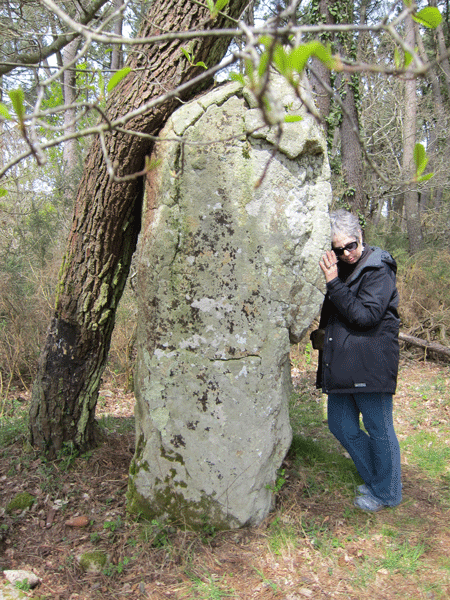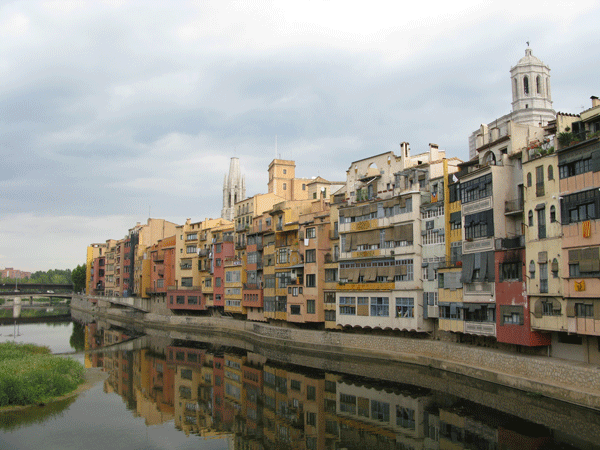The Alignments in Carnac, Brittany, France
words + photos by Elyn Aviva
We drove around a corner and encountered an astounding sight: row after row of standing stones, stretching to the horizon. “Pull over!” I demanded. Barely waiting for Gary, my husband, to stop the car, I opened the door, jumped out, and ran over to the green metal fence that separated the stones from me. I shook my head in disbelief, in awe. So many stones, lined up and going—where? Why? They fit no category I knew: they were an enormous puzzle of countless granite megaliths pointing to the sky, rooted in the earth. Hundreds, thousands of stones lined up in slightly wavering rows that went on for kilometers, as if the stones were frozen in the act of marching—somewhere. What was the point? What did they mean? What were they for? The stones made no response.
Nowhere in the world has as many megalithic sites as Brittany, and Carnac is in the center of them. The amazing profusion of ancient remains includes isolated standing stones, rows of alignments, earth-covered tumuli, quadrilateral and oval enclosures, and table-like dolmens, each with its own energy and story.
The dolmens with their elaborately engraved interior walls are intriguing, but the 6000-year-old alignments fascinate me. Many of the original stones have been hauled off for re-use in nearby farmhouses and fences, but nearly 3000 menhirs (Breton for standing stones) remain. They are lined up in three sets of slightly undulating rows facing approximately northeast/southwest and extending for kilometers. Starting in the northeast are the Kerlescan alignments, followed by the Kermario alignments, and ending in the southwest with the Le Ménec alignments. The different sets contain from eleven to thirteen rows, and include from approximately 600 to nearly 1200 standing stones. Each set ends in the southwest with an ovoid or quadrilateral stone enclosure (or what remains of one). The cumulative effect of so many stones, so many alignments, extending for such a distance, is awesome.
Nobody knows why they were built, though theories abound. Some experts think the alignments are an immense astrological device, though why so many stones would be needed remains a question. Others believe that they were used for rituals involving cattle. Since there is evidence of a cattle cult from the Neolithic times up until the 1950s, this is a possible explanation, but again one has to ask: why so many rows? Earth-mysteries researchers contend that they are a kind of earth “acupuncture,” perhaps helping to stabilize the fault-filled land. Others claim that the alignments were a Roman encampment, or Roman soldiers turned to stone, or a Celtic temple (they long pre-date the Celts). They remain an enigma, an enigma that draws me like a magnet.
The first time I saw the rows of megaliths, I wondered what would it be like to walk among them—to be surrounded by that much granite. We drove over to the visitors’ center at Kermario and asked how to get into the alignments. The clerk told us that only a small section was open for exploration—and only with a French-language tour. She explained that the fence was necessary to protect the stones: people had treated them with disrespect, destabilizing them, so in 1991 the government had enclosed them behind five-foot-high green metal fences to protect them.
We bought tickets and joined the tour. Children posed beside the granite megaliths and photographers angled for the best shot while we wandered off, trying to find some quiet place to “be with” the standing stones. It was not to be. The ever-alert tour guide repeatedly called us back to her side.
After our thoroughly unsatisfying experience, we drove back down the road and spotted an old stone farmhouse converted into a shop in the middle of the Kermario alignments. The shop was filled with Breton flags, Breton-language books, tourist souvenirs, and snack food. I asked Marie, the proprietor, what she knew about the alignments.
According to her (and she had lived there her entire married life, a substantial amount of time), the government had spread weed killer in the fields to destroy the gorse that threatened to engulf the alignments—and that (followed by the use of garden tractors) had made the stones unstable. She whispered that the government was planning to close the road that runs alongside the alignments and build a new visitors’ center in another location.
“If they have their way, you won’t be able to even see the alignments without purchasing a ticket.” She rubbed her thumb and index fingers together. “It’s all about money.” Then she changed her tone. “The stones have always been a gathering place, a place of life. The sad thing is, the stones are losing energy, isolated from people who want to touch them.”
Marie belonged to a group fighting for open access to the alignments. She pulled a flyer from a stack of papers on a table, announcing the annual “Free Menhirs” event, a combination political-action and Breton-nationalism party, complete with music. We thanked Marie for her information, then strolled over to the nearest fence and looked with longing at the quarantined standing stones.
With the help of a good map provided by the local tourist office, we found other megalithic sites that were not fenced in. We explored partly buried dolmens and quadrilateral enclosures; we leaned our backs against giant standing stones and hiked on forest trails to sacred wells. But I still longed to walk among the alignments, to get a sense of what they were like from the “inside.”
Our last night in Carnac, we slept in a small B&B at the northeast end of the Kermario alignments. Around midnight we were startled awake by what sounded like a hunting horn. Once, twice, three times it blasted into the moonlit night. We were puzzled. Who would be hunting at night?
The next morning we walked from our B&B back down the alignments for a final view. But something was different: a long stretch of metal fence had been knocked over. The menhirs were free, or almost so! The hunting horn must have been a signal for protestors to free the menhirs—if only for a night.
Hardly believing our good luck, we stepped on the now-horizontal barricade and walked into the alignments. We stood among the stones at last. Unfortunately, I was too nervous to enjoy this unexpected opportunity. We weren’t supposed to be there, and I was worried that at any moment the police would arrive. And arrive they did. Just after we started walking back to our B&B, a police car pulled up beside us. The policemen looked at us suspiciously but then drove on.
Over the years, we have returned a number of times to Carnac. The visitors’ center at Kermario was burned down by “persons unknown” some years ago, and a new one has been constructed across from the Le Ménec alignments. Despite Marie’s predictions, the road has not been closed off, so you can still drive by the alignments. If you go off-season, a small stretch of the alignments may be open; if so, you can wander through the rows of stones without fear of being arrested.
But if not, or if you want to visit alignments that have never have been fenced in, drive a little north and west toward Erdeven and the Kerzerho Alignments. The road splits the alignments, but you can pull off into the parking lot and stroll through rows of impressive standing stones. There you may be able to experience the energy of the stones and draw your own conclusions about what they mean and what they were—and still are—for.
Elyn Aviva is a writer, fiber artist, and transformational traveler. Currently living in Girona (Catalonia), Spain, she is fascinated by pilgrimage and sacred sites. Her PhD in anthropology was on the modern Camino de Santiago in Spain. Aviva is author of a number of books on pilgrimage and journey, and she is co-author with her husband, Gary White, of the guidebooks series Powerful Places in … The most recent guidebook, Powerful Places in Brittany, will be published in September. To learn more about Elyn or her publications, go to www.pilgrimsprocess.com and www.fiberalchemy.com





